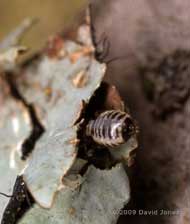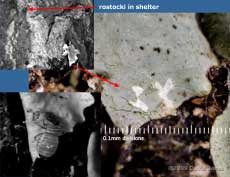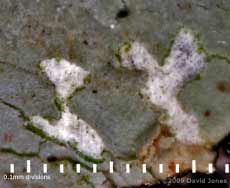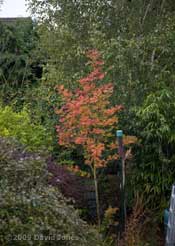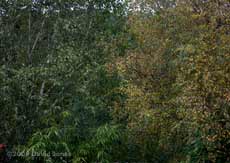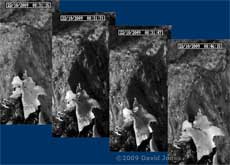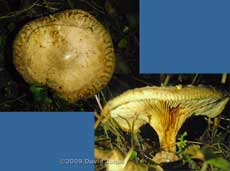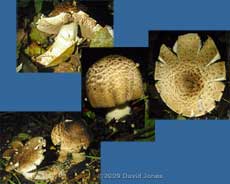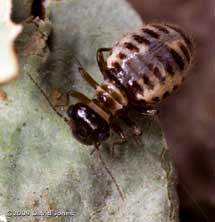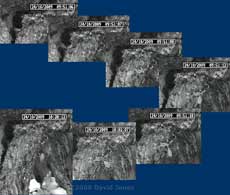Go to the last entry on this page .....Go to previous entry21 October - A dry, although cloudy day. Last night the temperature dropped to 8C on the veranda and reached a high of 16C this afternoon. After feeding at the end of the afternoon yesterday, rostocki remained inactive until just after midnight. at 12.29am she left the shelter, paused to defecate, and then headed down to the lichen again, and arrived there at 12.33am. This time it didn't climb onto the lichen but nibbled along the left-hand edge. It finished its meal at 12.49am and had returned to its shelter by 12.44am. At 5.02am it became active within the shelter for the next forty minutes. At 7.19am it left once again to feed at the left side of the lichen. With a long pause outside the shelter it over five minutes to meander slowly to the lichen, although it didn't defecate during the journey this time. It stopped feeding at 8.01am and returned to the shelter just a minute later. There was no activity seen between then and its next emergence came at 3.27pm when it produced a faecal pellet (back in shelter within two minutes). At 5.38pm it set out to feed for the third time today. I was surprised to see it stop to defecate again before arriving at the lichen at 5.40pm.
This time it chose a completely different part. As the picture indicates, it spent the whole session with its head tucked under the right hand side of the lichen. I wondered what effect my camera getting in close to take this photograph would have on rostocki, but I needn't have worried as it continued to feed for more than five minutes afterwards before it returned to its shelter at 5.55pm.
Looking back at yesterday's recording, the light areas were where the grazing took place, although the infrared image makes it difficult to tell how much of the surface had already been eaten away previously.
For example, notice how the some of the grazed area edges are lined with algae. Has this developed since yesterday, or was it this that rostocki was feeding on? During yesterday's feeding session rostocki appeared to move between all the light areas, visiting the area at bottom-right only briefly before leaving.
Its red leaves (especially when there are brighter moments) are in vivid contrast to the selection of green that still predominate. Clockwise from bottom-right in the picture the other large plants are the Hawthorn (dull green), the Berberis (purple), a plant in my neighbour's garden (yellow-green), the bare branches of his apple tree, our Himalayan Birch, and finally the bright green of a large bamboo plant. The aphids on this provide valuable honeydew for other insects at this time of year.
This second picture compares our Birch with our neighbour's native Birch tree with its smaller leaves that have lost their green colour.
22 October - After a quite mild night (min 11C) there was a bit of rain before I got up this morning, but the rest of the morning has been dry with some sunny spells (14C on the veranda just before noon, and just a degree higher during the afternoon) Rostocki's day started at 12.20am when it popped out to defecate. At 2.48am it left the shelter again, this time heading for the lichen. It stopped en route to produced another faecal pellet before going not to the 'leafy' part of the lichen but the black debris to the lower left of it. It finished feeding at 3.12am and returned to the shelter a minute later. It was out to feed again at 7.28am and took five minutes to meander its way to the lichen, although no pellet was produced during the journey. It fed first at the left edge of the lichen before moving on to the black material. This meal was completed at 8.06am and again it took less than a minute to return to the shelter. I needed to delve into one of my old Botany textbooks to remind myself that the black structures are in fact rhizinae (or rhizines) which are extensions of the underside of the lichen's leaf-like thallus (the lower surface of this is called the hypothallus). The rhizines are made up entirely of fungal hyphae and adhere the lichen to the bark (or other substrates, such as rocks). I understand that they also have the important function of absorbing water. This is then transported up through veins to the algae in the thallus where it is needed for photosynthesis. Once I saw that rostocki had settled again I went out (as I do at some point each day) to spray the log with a mist of rainwater. Afterward doing this, it's interesting to fast-forward the cctv footage to give a time-lapse sequence of what happens.
On the second image you can make out the water droplets as spraying takes place (it appears darker because I had to move a lighting reflector). The third image, recorded shortly afterwards shows that the droplets have either spread out, or have started to be absorbed. The lichen itself had drooped slightly. The final image, shows how the leafy part of the lichen has swollen and become more erect over the next fifteen minutes as a result of absorbing the rain water. Getting back to rostocki, it left the shelter briefly at 2.45pm the produce a faecal pellet. I have yet to establish just how far they travel when they are projected! At 4.33pm an extended period of activity began during which rostocki left the shelter twice in the direction of the area of algae to the right. It appeared to be extending the network of silk, but with the camera view as wide as it is it was difficult to be sure of this. A couple of times it stopped to nibble but there was no prolonged feeding. It was back in the shelter and settled by 5.34pm.
23 October - A largely sunny day with the temperature on the veranda getting up to 17C after an overnight low of 7C. A quiet day for rostocki with it feeding just once. It left briefly at 2.30am to defecate and then left the shelter again at 5.42am to arrive at the lichen four minutes later. This time it started off in the black, rhizine debris but also spent a short time on the thallus itself before returning to the shelter at 6.30am. During the rest of the day it left the shelter just one more time, to defecate again, and at 4pm it became active within the shelter for around forty minutes. At 10pm she left the shelter as though she was going to produce another faecal pellet, but once again she didn't appear to do so and returned to the shelter. Two sets of fungi pictures tonight.
In this case the cap is 10.5cm across and more or less flat-topped at the moment. With those markings around its rim I can't help but compare it with the top of a pie - not a good idea for a poisonous species!
The second fungus is coming up in the area below the sparrow feeder. In this case the largest cap (right picture) is about 6cm across the largest diameter. There is also a larger example that I didn't photograph and which measures are 8.5cm across. I think that these are Shaggy Parasols (Lepiota rhacodes).
24 October - A day that saw a mixture of sunshine, somewhat blustery showers and periods of drizzle. An overnight low of 10C was followed by a high of 18C during the afternoon. Rostocki's day started soon after midnight, although she had already positioned herself by the exit at 12.50pm. She left the shelter at eight minutes after midnight, headed down to the lichen, and spent 25 minutes feeding before getting back to the shelter at 12.37am. She visited the lichen again before dawn, leaving the shelter at 4.47am and meandering down this time, taking over five minutes to get to the lichen. Once there she spent most of her time amongst the black rhizines, spending just a short time on the thallus before ending the meal at 5.06am and taking less than a minute to return 'home'. She was active within the shelter between 9.40-9.45am.
At 11.42am she left the shelter once again, defecated (pellet clearly projected), and then went on to feed once again. At one point I could see her grazing on algae on the bark itself, to one side of the lichen, although it had climbed onto the thallus by the time I captured this picture, probably the clearest shot I've managed yet of a Pseudopsocus rostocki. It returned to the shelter at noon.
After a nine minute pause she embarked on a series of active periods within the shelter, from 12.09-12.45pm, 1.00-1.30pm, and 2.22-2.28pm. Again, the camera is too far away to see what she was doing, although I think that for a bit of the time she was adding silk to the canopy. At 4.41pm she left briefly to defecate again. At 5.15pm she moved to the exit, and after a long pause she headed directly to the lichen for the forth time today. This time she spent the whole session under the thallus, finishing at 5.37pm and getting back to the shelter within a minute (as usual, the journey home was much quicker that the journey out). While I have been monitoring rostocki (since 3 October) it appears to have had a very 'laid back' existence, just popping out for its shelter to feed and defecate, and it hasn't been disturbed by other creatures. However, live for barkflies isn't without its perils. At 9.51am two small creatures suddenly appeared at the top of the image - a barkfly nymph followed very closely by a mite. While they were close to the limit of the camera resolution, I have extracted this sequence. The nymph was clearly trying to escape the mite which seemed to have hold of its rear end. When the nymph stopped, the mite dashed to its side and started to suck up its bodily fluids. Over the next ten minutes or so the mite moved around its victim to feed on other areas of its body In the last but one image of the sequence you can see how much the appearance of the nymph has changed. The mite finally moved away and out of sight at 10.28am.
If you click on the composite image to see the larger version I have also included some of the individual images which, while still of low quality, show the mite and nymph more clearly.
25 October - Last night's low was 11C. For most of today we had blue skies and sunshine, which brought us a high of 18C on the veranda, although the afternoon ended and dusk approached with showers. Dusk came an hour earlier today since the clocks changed from British Summer Time to Greenwich Mean Time during the night. The first timing for rostocki is in BST - she left the shelter to produce a faecal pellet at 10.34pm. At 12.13am (BST) she started a period of quite vigorous activity which included work on the silk canopy and extended out a short way. She finally settled again just over 50 minutes later at 12.04am (GMT). From now on all timings are GMT - At 3.14am she left briefly to defecate but I didn't see a pellet produced. At 6.25am she left the shelter again, and two minutes later arrived at the lichen. She spent this feeding session on top of the lichen thallus, leaving at 6.58am and taking just a minute to return to the shelter. The only other activity during the day was her leaving for just a minute to defecate at 4.04pm. It produced another pellet at 5.56pm. At 10pm an extended period of activity began. For the first hour it was confined to the shelter, but after 11pm it extended out to the right and down a bit more, until rostocki returned to its shelter quickly when a earwig appeared at the right edge of the image. No photographs today, but looking out of the window this morning I noticed that the dozen Goldfinches that were at the feeders had been joined by the first Greenfinch that I've seen in the garden since March.
26 October - A low of 11C last night followed by a high of 17C today. At 3am rostocki left the shelter and disappeared below the edge of the image frame. At 3.48am it reappeared at the lichen where it fed under the thallus, on the log to the right of it, and finally had a quick nibble on the thallus itself before heading back to the shelter at 4.02am. It returned to the lichen at 7.02am. This time it grazed at the edge of the thallus before spending time on the top. That meal was completed at 7.38am and it was back in the shelter a minute later. Rostocki didn't feed again today, but left the shelter to defecate at 11.25am, 4.51pm and 11.27pm. A earwig appeared again at 5.52pm and 5.52pm.
27 October - A low of 12C last night and a high of 19C on the veranda today - quite remarkable temperatures as we approach the end of October. The predatory mite was about again today, making its first appearance at 1.42am as it searched other parts of the visible area but stayed away from rostocki's shelter. Rostocki's first activity of the day was to defecate at 2.24am. At 4.33am it left the shelter briefly during a short period of activity to produce another pellet. At 6.36am the mite appeared again and this time got within millimetres of the shelter. Rostocki didn't respond then, but three minutes later it left the shelter. This didn't seem to be in response to the mite's visit as it meandered down to the lichen. It started to feed but when the mite arrived again it headed out of frame. After a few minutes it returned to the lichen and continued to feed until it left at 7.05am to return to the shelter a minute later. At 7.42am it headed back down to the lichen and grazed on the edges and top until 8.09am. As usual it took a minute to return to the shelter. After that there was a long period of inactivity apart form about five minutes activity in the shelter at 2pm and a two minute trip out to defecate. At 5.04pm rostocki started on another long period of activity, this time strictly within the shelter, and which ended at 6pm. There was no further activity before midnight.
28 October - An overnight low of 11C and a high of 19C during the day as the mild spell continues, and it was dry. At 12.31am and 5.03am rostocki left briefly to defecate. At 6.47am it left to feed on the lichen, and on the log to the right of it. That meal ended at 7.35am and it arrived back at the shelter a minute later. After that there was no further action until a very small barkfly nymph appeared by the lichen at 4.25pm and spent half an hour grazing on the the bark surface to the left of it. At 5pm rostocki became active for just over an hour, although it remained completely within the shelter. Its only other activity today was when it left the shelter briefly at 11.10pm. Once again it looked as though it was going to defecate, but I don't think it did.
29 October - A marginally cooler day with a high of 18C after an overnight low of 10C - still dry and bright! Rostocki started the day by leaving the shelter briefly at 12.35am to defecate. It was 6.44am when it was next active, meandering to the lichen and grazing at the top edge of the thallus. However, at 6.59am it was dusturbed when the predatory mite appeared and it headed directly back to its shelter. The mite didn't attempt to catch rostocki but did catch and feed on a small barkfly nymph, the incident taking place largely out of sight under the lichen thallus. The mite was still under the lichen when rostocki left the shelter once again and returned to the lichen to continue its meal. Disturbed by the mite again, this time it disappeared down below the image frame. When it did reappear aT 7.47am it undertook a period of intense feeding before heading back to the shelter at 7.55am. The mite remained active in the area until 8.15am. It was 4.33pm when rostocki undertook a short period of activity in the shelter and left just to defecate at 5pm. Another five minutes of activity took place at 5.50pm. During the afternoon there were several periods of activity by small barkfly nymphs. This levle of activity hasn't been seen since I started this monitoring of rostocki. And at 6.41pm a wingless barkfly (nymph?) that was as large as rostocki appeared briefly for the first time. While monitoring will continue unabated, I will not be updating the diary for at least the next three days. We are still going to be about, but we'll be devoting the whole weekend to activities surrounding the wedding of one of our sons - it's going to be a grand weekend! It may also go some way to explaining the rather restricted nature of the diary over the last couple of weeks...
Click on images to see larger version |
|
